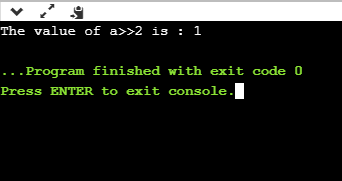Bitwise Operator in C ❮ Edit Details
The bitwise operators are the operators used to perform the operations on the data at the bit-level. When we perform the bitwise operations, then it is also known as bit-level programming. It consists of two digits, either 0 or 1. It is mainly used in numerical computations to make the calculations faster.
We have different types of bitwise operators in the C programming language. The following is the list of the bitwise operators:
| Operator | Meaning of operator |
|---|---|
| & | Bitwise AND operator |
| | | Bitwise OR operator |
| ^ | Bitwise exclusive OR operator |
| ~ | One's complement operator (unary operator) |
| << | Left shift operator |
| >> | Right shift operator |
Let's look at the truth table of the bitwise operators.
| X | Y | X&Y | X|Y | X^Y |
|---|---|---|---|---|
| 0 | 0 | 0 | 0 | 0 |
| 0 | 1 | 0 | 1 | 1 |
| 1 | 0 | 0 | 1 | 1 |
| 1 | 1 | 1 | 1 | 1 |
Bitwise AND operator
Bitwise AND operator is denoted by the single ampersand sign (&). Two integer operands are written on both sides of the (&) operator. If the corresponding bits of both the operands are 1, then the output of the bitwise AND operation is 1; otherwise, the output would be 0.
For example,
- We have two variables a and b.
- a =6;
- b=4;
- The binary representation of the above two variables are given below:
- a = 0110
- b = 0100
- When we apply the bitwise AND operation in the above two variables, i.e., a&b, the output would be:
- Result = 0100
As we can observe from the above result that bits of both the variables are compared one by one. If the bit of both the variables is 1 then the output would be 1, otherwise 0.
Let's understand the bitwise AND operator through the program.
- #include <stdio.h>
- int main()
- {
- int a=6, b=14; // variable declarations
- printf("The output of the Bitwise AND operator a&b is %d",a&b);
- return 0;
- }
In the above code, we have created two variables, i.e., 'a' and 'b'. The values of 'a' and 'b' are 6 and 14 respectively. The binary value of 'a' and 'b' are 0110 and 1110, respectively. When we apply the AND operator between these two variables,
a AND b = 0110 && 1110 = 0110
Output
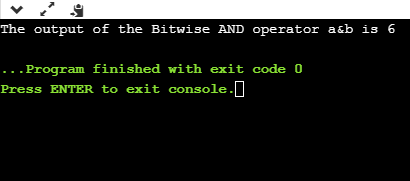
Bitwise OR operator
The bitwise OR operator is represented by a single vertical sign (|). Two integer operands are written on both sides of the (|) symbol. If the bit value of any of the operand is 1, then the output would be 1, otherwise 0.
For example,
- We consider two variables,
- a = 23;
- b = 10;
- The binary representation of the above two variables would be:
- a = 0001 0111
- b = 0000 1010
- When we apply the bitwise OR operator in the above two variables, i.e., a|b , then the output would be:
- Result = 0001 1111
As we can observe from the above result that the bits of both the operands are compared one by one; if the value of either bit is 1, then the output would be 1 otherwise 0.
Let's understand the bitwise OR operator through a program.
- #include <stdio.h>
- int main()
- {
- int a=23,b=10; // variable declarations
- printf("The output of the Bitwise OR operator a|b is %d",a|b);
- return 0;
- }
Output
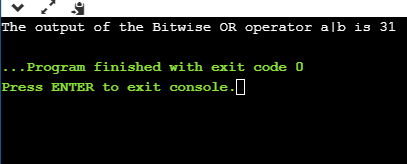
Bitwise exclusive OR operator
Bitwise exclusive OR operator is denoted by (^) symbol. Two operands are written on both sides of the exclusive OR operator. If the corresponding bit of any of the operand is 1 then the output would be 1, otherwise 0.
For example,
- We consider two variables a and b,
- a = 12;
- b = 10;
- The binary representation of the above two variables would be:
- a = 0000 1100
- b = 0000 1010
- When we apply the bitwise exclusive OR operator in the above two variables (a^b), then the result would be:
- Result = 0000 1110
As we can observe from the above result that the bits of both the operands are compared one by one; if the corresponding bit value of any of the operand is 1, then the output would be 1 otherwise 0.
Let's understand the bitwise exclusive OR operator through a program.
- #include <stdio.h>
- int main()
- {
- int a=12,b=10; // variable declarations
- printf("The output of the Bitwise exclusive OR operator a^b is %d",a^b);
- return 0;
- }
Output
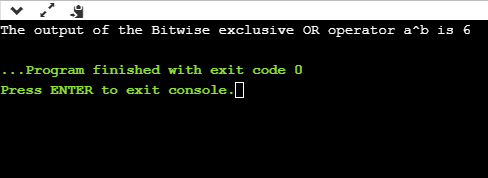
Bitwise complement operator
The bitwise complement operator is also known as one's complement operator. It is represented by the symbol tilde (~). It takes only one operand or variable and performs complement operation on an operand. When we apply the complement operation on any bits, then 0 becomes 1 and 1 becomes 0.
For example,
- If we have a variable named 'a',
- a = 8;
- The binary representation of the above variable is given below:
- a = 1000
- When we apply the bitwise complement operator to the operand, then the output would be:
- Result = 0111
As we can observe from the above result that if the bit is 1, then it gets changed to 0 else 1.
Let's understand the complement operator through a program.
- #include <stdio.h>
- int main()
- {
- int a=8; // variable declarations
- printf("The output of the Bitwise complement operator ~a is %d",~a);
- return 0;
- }
Output
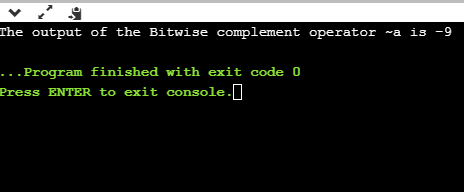
Bitwise shift operators
Two types of bitwise shift operators exist in C programming. The bitwise shift operators will shift the bits either on the left-side or right-side. Therefore, we can say that the bitwise shift operator is divided into two categories:
- Left-shift operator
- Right-shift operator
Left-shift operator
It is an operator that shifts the number of bits to the left-side.
Syntax of the left-shift operator is given below:
- Operand << n
Where,
Operand is an integer expression on which we apply the left-shift operation.
n is the number of bits to be shifted.
In the case of Left-shift operator, 'n' bits will be shifted on the left-side. The 'n' bits on the left side will be popped out, and 'n' bits on the right-side are filled with 0.
For example,
- Suppose we have a statement:
- int a = 5;
- The binary representation of 'a' is given below:
- a = 0101
- If we want to left-shift the above representation by 2, then the statement would be:
- a << 2;
- 0101<<2 = 00010100
Let's understand through a program.
- #include <stdio.h>
- int main()
- {
- int a=5; // variable initialization
- printf("The value of a<<2 is : %d ", a<<2);
- return 0;
- }
Output
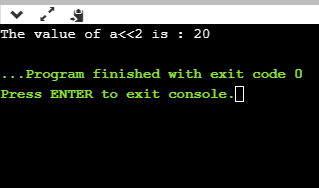
Right-shift operator
It is an operator that shifts the number of bits to the right side.
Syntax of the right-shift operator is given below:
- Operand >> n;
Where,
Operand is an integer expression on which we apply the right-shift operation.
N is the number of bits to be shifted.
In the case of the right-shift operator, 'n' bits will be shifted on the right-side. The 'n' bits on the right-side will be popped out, and 'n' bits on the left-side are filled with 0.
For example,
- Suppose we have a statement,
- int a = 7;
- The binary representation of the above variable would be:
- a = 0111
- If we want to right-shift the above representation by 2, then the statement would be:
- a>>2;
- 0000 0111 >> 2 = 0000 0001
Let's understand through a program.
- #include <stdio.h>
- int main()
- {
- int a=7; // variable initialization
- printf("The value of a>>2 is : %d ", a>>2);
- return 0;
- }
Output
